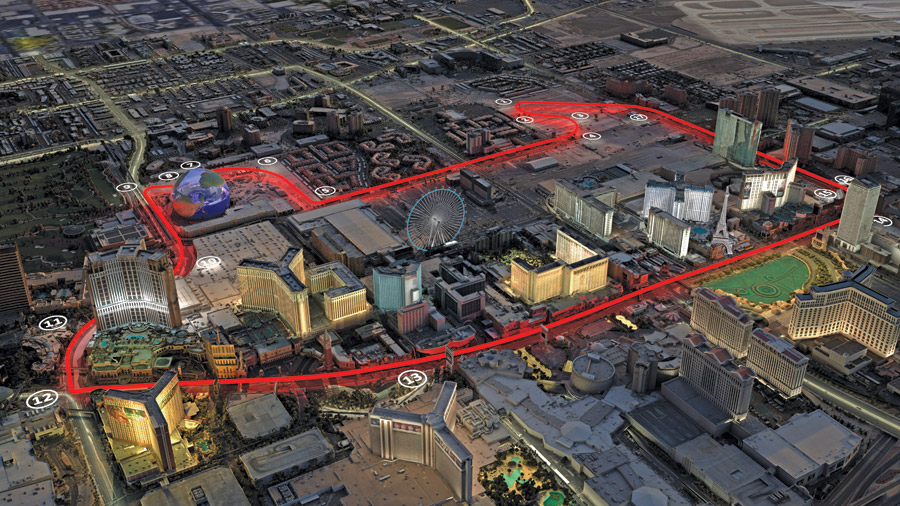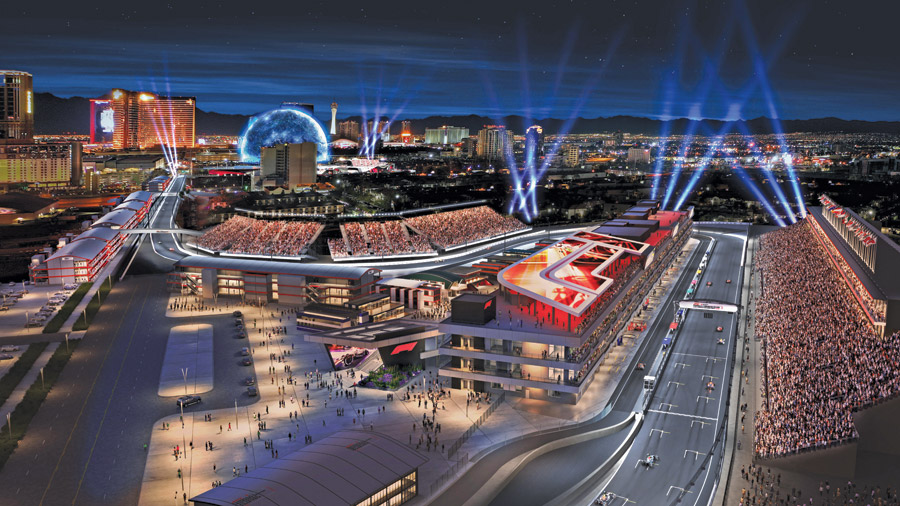Digging Deeper | Sports/Entertainment
Las Vegas Grand Prix Team Bolts Ahead on Fast Track Delivery

The 1,000-ft-long paddock building will serve as the pit area for race teams and will provide hospitality space for spectators to watch the start and finish line.
Photo Courtesy The Penta Building Group
Pacing the lightning-fast speed of Formula 1 racing cars, crews dash toward the finish line to construct the infrastructure for F1’s newest race in time for the green flag on Nov. 16.
Work to prep for the Formula 1 Heineken Silver Las Vegas Grand Prix includes construction of a 300,000-sq-ft paddock building and modification of 3.8 miles of Las Vegas streets, including the heavily trafficked Las Vegas Boulevard on the Strip. Crews will also assemble a complex array of temporary grandstands, vehicular and pedestrian bridges, barricades and event spaces. From initial foundation placement to the three days of races, the fast-track effort will take less than one year.
“We engaged local businesses, including the PENTA Building Group and Miller Project Management, to support our efforts and began procurement across both race and event operations very early on,” says Las Vegas Grand Prix Inc. CEO Renee Wilm. “As we race toward November, we’re working with some fantastically talented people, have a clear timeline to deliver and we are all working with a laser focus on those timelines.”

Running 3.8 miles and featuring 17 turns, the race track will fully encircle numerous resort properties along the Strip, requiring multiple temporary vehicular and pedestrian bridges.
Image courtesy Las Vegas Grand Prix Inc.
Reducing Drag
While developing a new F1 race typically takes years, “we officially announced the race in March 2022 with the intention of racing on the 2023 calendar,” Wilm says. To accomplish the aggressive feat, LVGP, Miller, PENTA, architect Klai Juba Wald, structural engineer John A. Martin & Associates (JAMA) and others collaborated on design and mobilization.
“One of the greatest challenges was to look ahead at the long lead items and make decisions on procurement of significant elements before we had fully developed the design,” says Terry Miller, owner of Miller Project Management. Long lead items included elevators, escalators, electrical transformers, building emergency generators, glass and glazing and architectural exterior panels.
“One of the greatest challenges was to look ahead at the long lead items and make decisions on procurement of significant elements before we had fully developed the design.”
—Terry Miller, Miller Project Management
Tony Cornell, PENTA vice president of construction and the project executive, says that in one example, “we sat down with the electrical engineer and figured out what the needs were for the building. Then we went out to the different manufacturers and found out what everybody’s lead times were for that size of equipment and ultimately wrote the spec to fit that manufacturer so that we got the material in time.” As a result, instead of the 60- to 80-week typical lead times PENTA has seen recently on such electrical gear, the lead time was half that based on the selections the team made, he adds.
Miller says that communication with stakeholders has been another key to delivering the project on time. “The regulatory authorities were informed throughout the process of the design so that when the documents were delivered at the end of summer 2022, there were no surprises during the formal review in preparation for building permits issuance,” Miller says.
For the 1,000-ft-long by 100-ft-wide paddock building, the team settled on a concrete structure to avoid longer lead times for steel and worked on getting rebar details, shop drawings and reinforcing steel purchased, Cornell says.
Work began on site demolition in June 2022 to remove an old apartment building and nightclub, among other structures. The discovery of asbestos-lined water pipes within the apartment foundations required abatement. Power lines were also relocated underground.


Cooling stations and water brigades help combat summer heat, while mobile fall-arrest systems (right) provide robust yet flexible protection.
Photos courtesy The Penta Building Group
The site originally sloped downward by about 25 ft from the southwest corner to the northeast corner. “We raised the entire paddock site to create a plinth on which the paddock building sits,” says Miller. This required more than 250,000 cu yd of engineered fill to level the site for the building and track, work that started in September.
By November, work began on the foundation, which includes 158 3.5-ft-deep spread footings that range between 9 ft sq and 15 ft sq, says Don Farnham, general superintendent with PENTA.
Crews went vertical in December and interior finishes began in February. The long hall-like structure features an expansion joint in the middle, allowing construction to be sequenced as if it were two separate 500-ft-long buildings, Farnham says. For concrete placement, “we started out with two crews, two 10-hour shifts, seven days a week” going in each direction. “Once we had the forms stripped out, our MEP trades had the same approach with two separate crews, and they just chased it as two separate buildings until we met in the middle. That was one of our time-saving approaches.”
At peak, the paddock site sees around 400 workers during the day shift and 100 during nights. Track work employs another 60 or so workers.
Unlike at many other projects around the U.S., finding workforce hasn’t been an issue. “A lot of the other big projects that were supposed to start [in Vegas] have all drifted to fourth quarter this year or first quarter next year,” Cornell says. “So from a labor and raw materials standpoint, we had the best [selection available] and right at our fingertips.”


Crews accommodated late changes to the design, including adding footings for a 28,000-sq-ft scoreboard on the roof and incorporating a pedestrian tunnel (right) on the north side of the site.
Photos by Scott Blair/ENR
Bragging rights to build the F1 facilities in the sports-crazed city also doesn’t hurt. “Everybody wants to be a part of the project,” he says. “The excitement levels are there.”
Pit-crew garages for each of the 10 racing teams occupy the paddock’s first floor. The second and third floors house hospitality and event space with outdoor terraces, and will also provide office space for F1. The roof has additional viewing and event space.
To eliminate cable trays and provide a smooth deck, JAMA incorporated steel cable troughs into the structural design that were cast into each floor deck, says Farnham. The approximately 7,700 lineal ft of troughs will be covered with an aluminum top to complement the polished concrete floors.
Moving so quickly meant that there were occasional late modifications to the design. One of the most significant that occurred after building construction began was the addition of a tunnel at the north end to allow pedestrians to safely pass underneath the track, plus a small elevator lobby and stairwell.
Because sequencing progressed from south to north, “we stopped the building short by about 100 ft and then went into full design on the tunnel,” says Cornell. After expedited permitting, crews installed a beam and lagging wall to allow completion of the building as tunnel work progressed using large precast concrete sections. The building has since topped off, and tunnel work has just about wrapped up.
“It’s obviously not ideal to add a tunnel to the end of the building when you’re already heavily under construction, but the team did a great job of working that out,” he adds.
A massive 28,000-sq-ft Samsung LED display in the shape of the F1 logo became another late addition to the rooftop.
Installing about a mile of underground utilities has become the current big push at the site to allow for paving to begin in July.
Keeping Track
For the 17-turn track that fully encircles some of the Strip’s most popular properties, “frequent meetings were held within the resort community to make sure they understood how we would pave the entire circuit, allowing them to communicate with their workforce and customers about the disruptions and procedures to mitigate traffic congestion,” Miller says.
In addition, LVGP, F1, FIA (the governing body for the F1 circuit) and race teams were all instrumental in ensuring the track and structures met performance expectations, he says.
During work conducted mostly at night by Las Vegas Paving, track construction involves removing between 6 in. and 10 in. of existing roadway, modifying intersections and removing some medians. Next, crews place a denser and stronger 7.5-in.-thick base layer, which is then paved to create a higher performance surface appropriate for the race vehicles. The finished route will be roughly twice as strong as a typical roadway and is expected to last about twice as long before needing to be resurfaced, the team says.
“We are putting together a city-wide event that is intended to be here long term.”
—Renee Wilm, CEO, Las Vegas Grand Prix
To date, Las Vegas Boulevard and Sands Avenue have been paved with the initial layer. The last portion will be through the $2-billion-plus MSG Sphere site, since that separate project is currently still wrapping up. Expansive grandstands, viewing areas, venues and safety barricades will encompass the five turns planned for the Sphere site.
Significant temporary structures abound throughout the rest of the project’s length. “The race circuit will encapsulate nearly 23,000 rooms each of the three nights of the race,” says Miller. To provide resort access, the team will construct three temporary vehicular bridges a month before the event. Once in place, the bridges will serve as public roadways even when the racetrack is not in use. “The bridges have been specifically designed to support the equivalent of highway traffic, including emergency and safety vehicles from the local fire and law enforcement agencies,” he adds.
Multiple pedestrian bridges will also be erected along the track and paddock site as well as grandstands that will hold the many thousands of spectators.
The track will also be encompassed by substantial safety fencing and concrete barriers, and crews will stay on even after construction ends to handle the logistics of opening and closing public roadways and access to resorts before and after each race.

In addition to the permanent paddock building, expansive temporary grandstands, hospitality suites, pedestrian bridges and safety fencing will be assembled for the multi-race event on Nov. 16-18.
Renderings courtesy Las Vegas Grand Prix

Marshalling safety
With the area’s typical summer heat settling in, PENTA has set up an air-conditioned cooling station as well as a “Gatorade brigade,” aka personnel that walk the site and hand out electrolyte-rich refreshments, says Farnham.
Adds Cornell: “The safety level is very high on the job. You can’t have a dirty and unorganized site and get the job done at this speed. So we are making huge efforts to keep it clean, organized and safe.”
“Everybody wants to be part of this project. The excitement levels are there.”
—Tony Cornell, Vice President, PENTA
PENTA found benefits to sequencing and also boosted fall protection using multiple mobile fall-arrest systems that can be easily moved around with a crane or forklift to allow multiple workers to tie off to, instead of having standard guardrail systems that are usually in place long term, says Cornell.
The paddock building will be turned over to LVGP in late September and prepped for the Nov. 15 opening ceremony.
Even after the teams depart for the next race on the circuit and the temporary bridges and grandstands are broken down, LVGP sees a long road ahead. “We are putting together a city-wide event that is intended to be here long term, and we want to make our mark in the local community,” says Wilm.
“In February, the county provided us with the certainty that race weekend would be available on the calendar through 2032,” she adds. “Ultimately, our goal is to establish Las Vegas as the home of Formula 1 in North America and utilize the LVGP Paddock Building all year long.”


